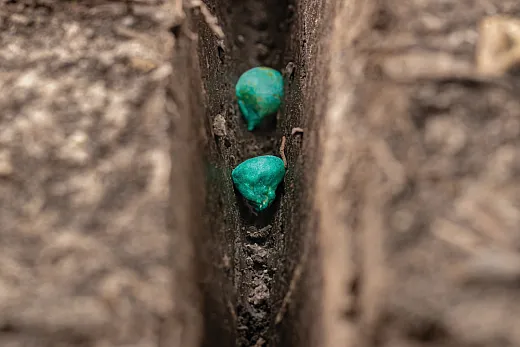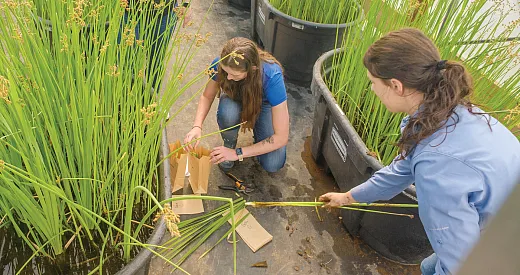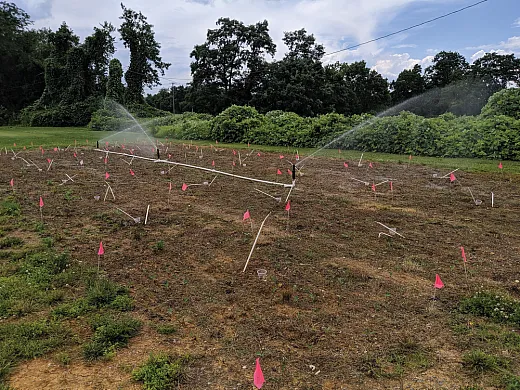Wetlands, Soil Organic Matter, and Neonicotinoids
New Research Provides Important Information for Efforts to Limit Non-Target Exposure of the Insecticides

Neonicotinoids are the most widely used class of insecticides, used primarily as seed coatings in agricultural crops, but also on lawns, gardens, golf courses, and in flea and tick pet treatment.
A major concern with the use of neonicotinoid insecticides is their effect on non-target species, such as honeybees and other beneficial insects.
One recent study in the Journal of Environmental Quality explored the impacts of “floating treatment wetlands” on neonicotinoid and nitrate mixture removal, and another in the same journal worked to discern if soil organic matter can limit leaching of neonicotinoids from soil.
Neonicotinoids are the most widely used class of insecticides, used primarily as seed coatings in agricultural crops, but also on lawns, gardens, golf courses, and in flea and tick pet treatment.
A major concern with the use of neonicotinoid insecticides is their effect on non‐target species, such as honeybees and other beneficial insects.
One recent study in the Journal of Environmental Quality explored the impacts of “floating treatment wetlands” on neonicotinoid and nitrate mixture removal, and another in the same journal worked to discern if soil organic matter can limit leaching of neonicotinoids from soil.

Neonicotinoids came on the scene in the early 1990s and quickly became the most widely used class of insecticides. In 2004, they began to gain more popularity as a seed coating. Today their dominant use is as seed coatings in agricultural crops like corn, cotton, soybeans, and canola, but they are also used on lawns, gardens, golf courses, and in flea and tick pet treatment.
Scientists have well established that neonicotinoids persist in the environment in their parent forms and in degraded forms, some of which are more toxic to insects than the parent form. A major concern with the use of neonicotinoid insecticides is their effect on non‐target species, such as honeybees and other beneficial insects.
The insecticides are degraded by ultraviolet light from the sun and will ultimately break down completely into nontoxic forms. However, research has shown this does not occur effectively enough to remove it quickly from the environment. For example, sunlight can only penetrate water a few inches, so if a body of water is not circulating, much of the insecticides will not be broken down.
Many researchers are studying potential strategies for removing or slowing down their movement into the environment as well as the effects of neonicotinoids on ecosystem services. One recent study in the Journal of Environmental Quality explored the impacts of “floating treatment wetlands” on neonicotinoid and nitrate mixture removal, and another in the same journal worked to discern if soil organic matter can limit leaching of neonicotinoids from soil.
Floating Treatment Wetlands
A research group led by Tiffany Messer, assistant professor of biosystems and agricultural engineering at the University of Kentucky, is focused on tracking and treating environmental contaminants in water. Their work has monitored neonicotinoid insecticides in rivers and lakes and found them to be relatively ubiquitous across different landscapes, not only in agricultural areas, but also in urban settings, such as in wastewater effluent and downstream from golf courses and dog parks. This includes different wetland systems. Because wetland systems remove nutrients such as nitrogen from water, the researchers became interested in how the insecticides may affect the capacity of a wetland to carry out this function.
“Since we found neonicotinoids entering wetlands, we wanted to see the impact of neonicotinoids on wetlands’ capacity to remove nitrogen from water,” Messer says. “Another interest was if the plants take up insecticides, and if so, where are they going in the plant? This could help us understand if the insecticides could impact non‐target species or be an avenue for removal of these insecticides from the environment.”
Floating treatment wetlands are raft‐like structures covered in wetland plants that are suspended in water, allowing the roots to grow into the water and the vegetation to grow above the water. They can be used to remove nitrogen from water, particularly in areas where there is not space for a conventional surface treatment wetland system, such as recreational ponds or stormwater detention systems. The floating treatment wetlands can be placed on the top of the reservoir, and the plants—and especially the microbes that live on the plant roots and surrounding soil—remove nitrogen from the system.
Their 21‐day experiment was devised to investigate if the presence of neonicotinoids—imidacloprid and thiamethoxam specifically—impacts the plants’ and microbes’ ability to treat nitrogen and if the plants and microbes degrade the insecticides. Messer says that often the by‐products of the insecticides are more toxic to non‐target species than the parent product, so they not only measured the parent product at the end of the experiment but many degradation products.
“For about 50 years, this field has been studying how nutrients are removed from wetlands, but in recent years, we have started to realize that it’s not only nitrogen and phosphorus entering these systems.” Messer explains. “It’s a cocktail of these elements in addition to insecticides, antibiotics, personal care products, per‐ and polyfluorinated substances (PFAS), and more. There is a lot flowing into these systems, but we have been limited in researching what these mixtures do to nitrogen or phosphorus removal processes in wetlands and if wetlands can mediate these emerging contaminants.”

Management Implications for Wetlands
Overall, their results showed that the presence of the insecticides did not impact nitrogen transformation via microbial denitrification. They also found that during the brief experiment, a small amount of the insecticides were taken up by the plants and primarily stored in the root zone although some was found in the plant shoots. The findings hint at how a wetland would need to be managed to remove the insecticide as well as ways to reduce the risk of the insecticides impacting non‐target species.
Because the insecticides taken up by the plants were stored mostly in the root zone, it makes removal difficult. Other contaminants that are stored in the stems and leaves can be mowed and removed from the system. To remove the roots, the entire plant would have to be removed and then replanted, which is often not economical. Messer also notes that this study was done at the end of the growing season, and it is possible further studies would show the insecticides reside in different parts of the plant during certain times of the year.
Another aspect is animals or insects who eat or use wetland vegetation that may contain neonicotinoids. For example, if there are substantial honeybee populations around a wetland with high concentrations of the insecticides, it may change the ideal strategy for managing the wetland. This includes what species are grown in the wetland; rush and sedge species are typically not big pollinators plants, but milkweed is. Messer’s group recommends avoiding planting pollinator species in designed wetland systems that have high levels of neonicotinoids coming into them.
“It was an important study to recognize that, yes, these are low concentrations of the insecticides going into the wetland plants, but they are degrading into potentially more toxic by‐products,” Messer explains. “If and when they do that, there is a chance that non‐target species will be exposed to them. I would say our biggest finding was where these neonicotinoids are being stored in plants and the possibility that non‐target species can have exposure to them through the downstream wetland plants, just as much as the water.”
Impact of Soil Organic Matter on Leaching

ASA and SSSA member Ryan Stewart, associate professor of plant and environmental sciences at Virginia Tech, studied neonicotinoids in the environment from a different angle. In a recent paper in the Journal of Environmental Quality, his research group investigated if levels of soil organic matter can eliminate or delay the leaching of neonicotinoid insecticides from soil.
They studied two neonicotinoid insecticides: thiamethoxam (TMX) and its transformation‐product clothianidin (CLO). The study used thiamethoxam‐coated soybeans because seed coatings are a common application of this insecticide. They planted the seeds across fields with different amounts of soil organic matter due to previous amendments. Samples were collected for 10 weeks after planting and analyzed for insecticide concentrations. The analysis focused on rainfall events near the beginning, middle, and end of the study to understand leaching of the insecticides from the soil.
“We wanted to understand how organic matter influences the transport of neonicotinoids,” Stewart explains. “Initially it seemed like organic matter had a strong influence in reducing the amount of these compounds that were being leached. However, by the end of the growing season, the effect diminished. This showed us that the unique chemistry of the organic matter can interact and bind up the insecticide and slow down the transport.”
Spring Flush Benefit
He adds that, while the insecticides were not eliminated, this slowdown is a useful potential benefit, particularly during the period known as “spring flush.” This is a period early in the growing season that experiences a large rain or snow event that causes a lot of runoff and potential leaching. A spring flush tends to transport a large load of chemicals and fertilizers that were just applied.
“Higher soil organic matter can be a potential benefit here in that you’re slowing down or reducing that first flush,” Stewart says. “I think the timing suggests that it’s more of a holding on to than a breaking down. If it was breaking down, you likely wouldn’t see it come out of the system. The delay suggests that it’s probably a temporary absorption onto the organic matter.”
He adds that not all organic matter is created equal and that different kinds of organic matter have different molecular and chemical structures, meaning they have different surface functional groups. For example, polar and non‐polar molecules attract different components of the organic matter and, rather than being permanently stuck, are exchangeable and are dislodged as the solution chemistry changes throughout the season.
“Even though a lot of water is moving through the soil profile during these spring flush events, we did not see the concentrations of the insecticide that we expected,” he says. “The organic matter reduces the losses during this critical period. We found a correlation that more organic matter was associated with lower concentrations of insecticides leaching from the soil during spring flush.”
Stewart says their research also added further evidence to some established principles about leaching and organic matter. For example, they found a positive correlation between the amount of water and insecticides that leached from the plots, suggesting that strategies to reduce leaching overall can help reduce the offsite transport of insecticides as well. In addition, there are numerous other benefits to increasing the organic matter in soil.
“There are what we call co‐benefits, such as sequestering atmospheric carbon and building better soil health,” he says. “Even if organic matter cannot completely eliminate these insecticides, there are still cumulative benefits for building organic matter. Building soil carbon and reducing subsurface draining may provide outsized environmental and agronomic benefits.”
A Communal Challenge: Reducing Nontarget Exposure
John Tooker, a professor of entomology and Extension specialist at Pennsylvania State University who was not involved in either of these papers, has studied neonicotinoids’ impact on non‐target insect and non‐insect populations.

“These insecticides are super common in the environment and there are three parameters to consider: presence, exposure, and amount of exposure,” he explains. “For example, we know they are in waterways, but it can be unclear how toxic they are to the animals that live at the bottom of those waterways, or ponds or lakes. It seems like the insecticides reside in the water column so at the top are zapped by UV, but there are many insects that live at the bottom and we haven’t studied the impact on them in depth.”
He adds that one of the biggest challenges is that these insecticides are so effective that even a very small amount can be disruptive. The “environmental fate” of the insecticides can vary widely but is key to its impact on the environment. It’s not always guaranteed that the insecticides end up in a system where it’s effectively degraded by UV or another process.
“Research looking for ways to mitigate their impact and understand their impact on other ecosystem services is very useful,” Tooker says. “However, I worry that the scale of the use of these insecticides is so large that it’s difficult for mitigation efforts to have a large impact. Other avenues like limiting their overall use should also be important goals of policymakers, seed companies, and researchers.”
The typical concentrations Messer’s research group observes in water are toxic to non‐target species but are not at concentrations that are considered hazardous to humans by the USEPA.
“The EPA is not currently regulating by‐products of neonicotinoids,” she says. “Often the by‐product formations are at higher concentrations. However, it is not a regulatory issue at this point. We rarely, if ever, see a level that’s concerning for human exposure based on current EPA regulation.”
All of the researchers agree that it is vital to be thoughtful about the use of neonicotinoids and important to take efforts to keep them in the field when they are used.
“Anything we can do to keep them in the fields is a good thing because at this point, they are so common,” Stewart says. “Anything we can do to reduce non‐target exposure is going to have a benefit for ecosystem processes. It’s really a communal challenge for us to work together to reduce these concentrations and avoid unintended consequences from these insecticides.”
DIG DEEPER
To find out more about the Journal of Environmental Quality research highlighted in this story, please see: “Neonicotinoid Pesticide and Nitrate Mixture Removal and Persistence in Floating Treatment Wetlands”: https://doi.org/10.1002/jeq2.20411 “Soil Organic Matter Can Delay—But Not Eliminate—Leaching of Neonicotinoid Insecticides”: https://doi.org/10.1002/jeq2.20402
Text © . The authors. CC BY-NC-ND 4.0. Except where otherwise noted, images are subject to copyright. Any reuse without express permission from the copyright owner is prohibited.











